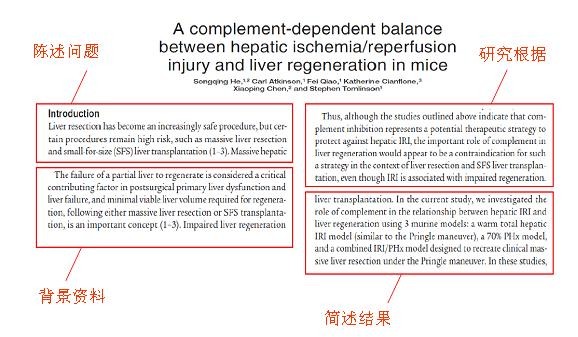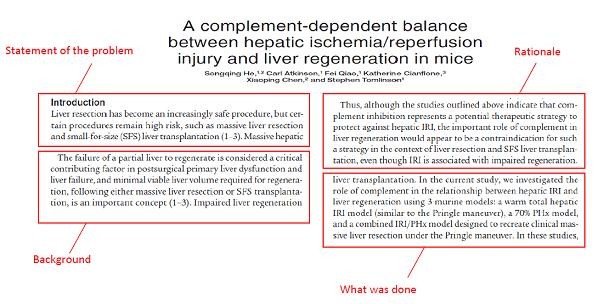博文
引言:布局
||

“引言”必须向读者提供足够的背景信息,让他们明白你工作的来龙去脉。它不必也不应是该领域的全面文献综述—那是综述性论文的事情。相反,它应指出“现有问题”,也就是你的研究问题,从而确立该研究的根据。“引言”还应简要说明你如何着手这个问题,以及你取得的进展。换言之,“引言”应交待清楚:已有哪些相关的工作、为何需要此研究、你做了哪些工作以及你发现了什么。
在你开展研究之前,应该开展全面的文献检索;否则,就存在炒冷饭的风险。不过,在你正进行研究的几个月时间里,也有可能有类似或相关的研究发表。因此,应当随时、持续地检索文献,以确保你能立即获悉该领域的最新动态。“引言”中引用的文献应该新颖、平衡、且与你工作息息相关。也就是说,①与你报道的工作不直接相关的不要引;②要引用正反两方面的相关论文。除了引用你自己发表的研究以及赞同你的研究结论的其他论文外,也要引用与你的结果矛盾或持不同观点的论文;3)就某一方面的结果,只引最新论文,除非是用早前的文献来说明某种思维或方法的发展演变。只需引用最少量的背景信息,使读者能明白你研究的依据就够了。若读者想了解更多细节,他们自己会去读相关综述。所以,许多作者常常采用引用综述来缩短他们的“引言”。
在“引言”结尾可以简述一下你做了什么以及得到了什么结果,这一般是个不错的写法,但不要过于详细,否则就会变成重复“方法”和“结果”中的内容;每个部分写一两句即可。最后,任何非标准缩写、技术术语以及读者可能不熟悉的术语都要在“引言”中定义清楚。例如,一篇关于利什曼原虫的研究论文如果直到“讨论”才提及利什曼原虫是一种皮肤病(利什曼病)的致病寄生虫,将很不利于读者理解(或令读者头痛)。类似地,一篇关于蛋白Bcl - 10的研究论文也应该在“引言”中就说明这种蛋白可导致细胞凋亡和激活信号分子NF-κB,而不要留到“讨论”才讲。
实例
上面这个的例子发表于The Journal of Clinical Investigation (doi:10.1172/JCT38289经授权转载)。作者先清楚地点出问题,接着用5段话的背景材料(此处略)来解释既有研究的结果及其意义;然后顺理成章引出本研究的根据,最后再水到渠成简介本研究的内容。本文作者不在“引言”中提及他们的研究结果,可能由于这里对本研究工作已叙述得比较详细,不过更有可能是由于JCI上的文章“引言”之后紧接着就是“结果”,而“方法”部分在“讨论”之后才出现。
核查清单
1. 用最少量的背景信息传达“现有问题”或者假说
2. 表述清楚“现有问题”或假说的背景。
3. 引用平衡的且较新的文献。
4. 明确定义技术术语和不常见的术语。
5. 最后一段简述做了哪些工作和取得了什么结果。
Introduction: setting the scene
The introduction must provide the reader with sufficient background information for them to put your work into context. It needn’t and shouldn’t be a comprehensive literature review of the field: that is what review articles are for. Instead, it should present “the problem”, basically whatever the research question is, thereby defining the rationale for the study. The introduction should also briefly explain how you addressed this problem and what was achieved. Put another way, it should be clear from the introduction what related work has been done before, why the current study was performed, what you did, and what you found.
A comprehensive literature search should have been performed before launching into your study; if not, you run the risk that someone has previously done what you intend to do. However, it is also possible that similar or related studies are published during the several months it takes to perform the research. Therefore, the literature should be reviewed on an on-going basis to ensure that you are up to date with all developments in your field of research. As with all references to the literature, the literature cited in the introduction needs to be current, balanced and relevant. What this means is that 1) you should not cite papers that don’t directly pertain to the research you plan to describe; 2) you must cite all relevant papers, not only your own research and papers that support your hypothesis, but also papers that contradict your findings or propose alternative ideas; and 3) only the most recent papers showing a particular finding should be cited, unless referring to an older paper to explain the evolution of thought in the field or the development of a particular method. The minimum amount of background for a reader to understand the rationale for your study is all that is required. If a reader wants to know more they will find a review on the subject; indeed, many authors refer readers to review articles for additional information, thereby reducing the length of their introduction.
It is usually a good idea to briefly describe what was done and what was found at the end of the introduction, but it is important not to go into too much detail or you will end up repeating what is already described in the methods and results sections. A sentence or two for each is usually sufficient. Finally, any non-standard abbreviations, technical terms and terms that might be unfamiliar to some readers should be clearly defined in the introduction. For example, in a paper describing research on Leishmania major, it would not be helpful (or appreciated by the reader) if it was left until the discussion to mention that this is a protozoan parasite responsible for the skin disease leishmaniasis. Similarly, in a paper describing findings relating to the protein BCL-10, the fact that it has been shown to induce apoptosis and activate the signaling molecule NF-κB should be mentioned in the introduction rather than being left until the discussion.
Example
In the example above, published in The Journal of Clinical Investigation (doi:10.1172/JCT38289; reproduced with permission), the authors clearly state what the problem is and follow this with five paragraphs of background (not shown) explaining the results of previous work and their implications. This leads nicely to the rationale for the study, which is logically followed by a description of what was done in the present study. The authors of this paper chose not to mention their findings in the introduction, possibly because the description of what was done was quite detailed, but most likely because the results section immediately follows the introduction in JCI papers, with the Methods coming after the Discussion section.
Checklist
1. Minimum amount of background required to understand “the problem”/hypotheses
2. Clearly framed “problem”/hypotheses
3. Balanced and current literature cited
4. Technical and non-familiar terms clearly defined
5. Brief description of what was done and what was achieved in the final paragraph
Dr Daniel McGowan
分子神经学博士
理文编辑学术总监
https://blog.sciencenet.cn/blog-288924-550438.html
上一篇:图表:一图值千字
下一篇:冠词/复数与单数

